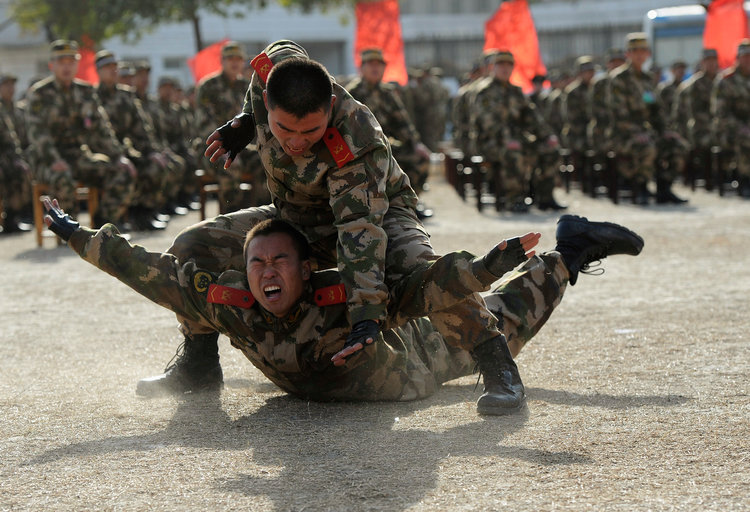[Analytics] China’s rapid military buildup is slowing down

(Business Insider)
It’s defense budget season for the world’s major powers. This week, US President Donald Trump presented his request for military spending for fiscal year 2020, an unprecedented US$750 billion, including a whopping $174 billion slush fund known as the “overseas contingency operations” account. Richard A Bitzinger specially for the Asia Times.
Now China has released its budget for military expenditures for 2019, and it, too, will reach an all-time high of 1.19 trillion yuan ($177.6 billion). This is a 7.5% rise over China’s 2018 defense budget of 1.107 trillion yuan.
At issue is not the fact that Chinese military expenditures are going up, but by how much. Chinese defense spending has increased every year since the mid-1990s, but lately the annual rise has been slowing.
Starting around 1997, China experienced double-digit real growth (that is, after taking inflation into account) in defense spending nearly every year. Even according to its own official national statistics (which many experts nevertheless believed substantially understate actual spending levels), China’s defense budget from 1999 to 2008 expanded at a rate of 16.2% per annum.
This trend remained basically unchanged throughout the first half of the second decade of the 21st century. Between 2009 and 2015, for example, Chinese military expenditures grew from 481 billion yuan ($70.3 billion) to around 886.9 billion yuan. Overall, between 1997 and 2015, Chinese military expenditures grew by at least 600%, after inflation.
In 1997, Chinese military expenditures amounted to only $10 billion, which was roughly on par with Taiwan and significantly lower than the defense budget of Japan or South Korea. Today, Chinese defense spending outstrips all other Asian and all European militaries, including Russia.
As a result, China has become the second-largest defense spender in the world (behind – no surprise here – the United States). What’s more, Beijing’s munificence to the People’s Liberation Army (PLA) has been remarkably affordable: despite the increases over the past 20-plus years, the country still spends only around 2% of its GDP on the military.
Defense spending slowing
Since 2016, however, the increase in Chinese military spending has witnessed a significant slowing. That year, the defense budget grew just 7.6% over 2015; this was followed by increases of 7% in 2017 and 8.1% in 2018.
In other words, for four years in a row now, defense spending rises have been stuck in single digits. This appears to signal a trend that Chinese military spending will be much more modest in the years to come. In fact, if measured in US dollars at current exchange rates, the 2019 increase is actually only 1.7% ($177.6 billion versus $173 billion in 2018).
China’s economy grew by 12.5% per annum from 1998 to 2007, but the defense budget expanded by nearly 16% every year
Keep in mind that these are reductions in budget increases, not defense cuts per se. Nevertheless, it appears that China can no longer afford double-digit increases in military spending at time when economic growth in China is slowing overall. Between 1998 and 2007, China’s GDP expanded at an average annual rate of 12.5%. Since 2010, however, GDP growth has fallen to below 7%.
For a long time, Chinese military spending exceeded GDP growth. China’s economy grew by 12.5% per annum from 1998 to 2007, but the defense budget expanded by nearly 16% every year.
Now, however, it appears that massive military expenditures are beginning to place an undue burden on the Chinese economy. The disconnect between economic performance and defense spending has become more and more pronounced, and as a result, huge defense spending increases are becoming prohibitive.
Global power ambitions
While defense spending growth may be slowing in China, Beijing’s potential for becoming a global power is hardly lessening. It may not have as much to spend on its military in the coming years, but it is still able to throw a lot of money at the PLA.
Here is one figure to keep in mind: $59 billion.
In the past, China used to issue defense white papers stating that approximately one-third of its military budget went to “equipment,” presumably monies for procurement, as well as for research and development (the Chinese later stopped providing any breakdown of its defense budget beyond a topline figure, presumably because it made them look bad).
Applying this formula to the 2019 budget, one-third comes out to $59.2 billion. How much can that buy you? A lot.
That figure outstrips the entire defense budgets of Japan, South Korea, France, Germany, or the United Kingdom. In fact, it would likely make any country the world’s third largest defense spender, behind the United States and Saudi Arabia.
You can buy a lot of equipment with $59 billion, and it shows: China is currently building its second indigenous aircraft carrier, and it is developing a new long-range stealth bomber and a large transport aircraft (comparable to the US-built C-17). In addition, the PLA is every year acquiring dozens of 4th- and 5th-generation fighter jets (including the J-20), new amphibious assault vessels, submarines, and frigates, and modern armored vehicles and artillery systems. It is also modernizing its nuclear forces, with new road-mobile ICBMs and missile-carrying nuclear submarines.
At the same time, China has not abandoned its militarization of the South China Sea, its efforts to expand into the Indian Ocean (including the establishment of its first overseas military base in Djibouti, on the Horn of Africa), or its ambitious Belt and Road Initiative.
Whether you call it a threat or a challenge, China’s drive to become a major global power is unabated, and a slowdown in defense spending is hardly going to make a dent in that campaign.
Richard A Bitzinger is a Visiting Senior Fellow with the Military Transformations Program at the S Rajaratnam School of International Studies, Nanyang Technological University, Singapore.